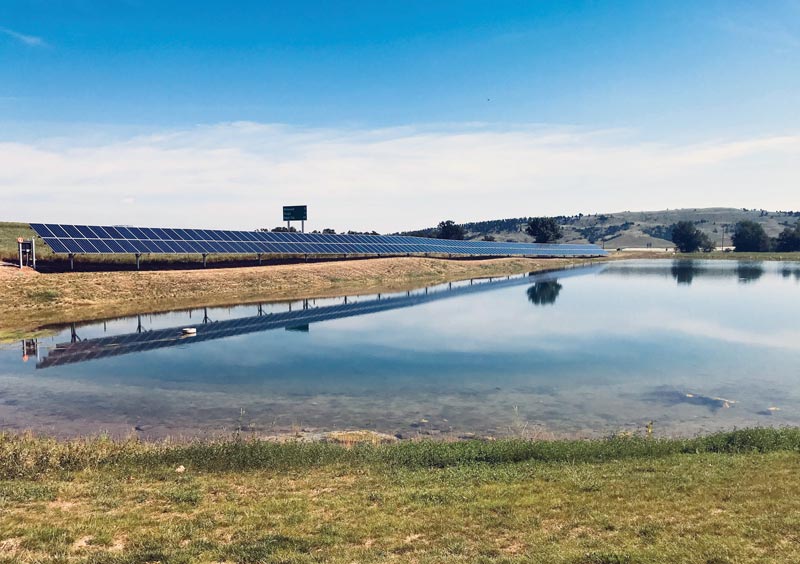
The 234-panel solar array on the north side of the irrigation pond on Elkhorn Ridge Golf Club’s 18th hole is projected to generate 120 megawatt-hours annually and pay for itself in 6½ years. Photo by Greg Brandriet
When Greg Brandriet, CGCS, first started looking into alternative energy sources for Elkhorn Ridge Golf Club in Spearfish, S.D., none of the options made much sense financially or politically.
Close to a decade ago, Brandriet, a 10-year GCSAA member, explored the idea and quickly settled on wind and solar as his top two alternatives. Brandriet toyed with the idea of installing a small wind turbine on the course, but Spearfish hadn’t yet drafted ordinances regarding wind power. Because Elkhorn Ridge’s back nine hadn’t been constructed and there was no room for solar panels on the front, Brandriet had no place to establish a solar station. Besides, the cost of photovoltaic cells at the time was high enough that solar didn’t make much financial sense.
“Our alternative energy plans,” Brandriet says, “were pretty much stalled.”
Then the environment changed. Elkhorn’s back nine opened, the price of solar dropped, and GenPro Energy Solutions, a company “down the road” from Spearfish in Rapid City, S.D., developed its solar portfolio and surfaced on Elkhorn Ridge’s radar.
In mid-August 2018, the course’s 234-panel array went online with the promise of providing 120 megawatt-hours per year and saving an estimated $13,000 in electricity costs annually.
“Overall, it’s been great,” Brandriet says. “The membership has given us nothing but good feedback. As it was going up, people were worried a little bit. It’s by a tee box. They were worried about glare. Really, there’s been none of that. The community feedback has been great.”
South Dakota is a bit of a mixed bag when it comes to solar energy. On the plus side, there’s a lot of sun. Some projections suggest regions of South Dakota get as much sun as parts of Florida, the Sunshine State. Only a handful of states — the usual suspects of Nevada, Arizona, California and the like — have more total “sunny hours” than South Dakota.
On the flip side, the political scene isn’t especially welcoming for solar, unlike some states that incentivize solar installations. Further, the cost of electricity in South Dakota is low — considerably lower than the national average — requiring a longer period for a solar project to recoup its initial cost. In the case of the Elkhorn Ridge array, that was $154,000.
As Brandriet found, South Dakota energy policy isn’t particularly solar-friendly. Any excess energy the Elkhorn Ridge panels produce can be returned to the grid, and the course will be paid for those kilowatt-hours — but at a discount. Brandriet says the buyback rate is 5 to 10 percent of the cost of buying from the grid.
“That takes some of the incentive out of it,” he says.
As a result, South Dakota — despite its radiant potential — ranks at the very bottom of nearly every gauge of solar adoption.
Regardless, Brandriet, with GenPro’s guidance, figured he’d break even in around 6½ years thanks in no small part to federal incentives that, according to Brandriet, cut the project’s cost nearly in half.
When it came to planning its array, the team at Elkhorn Ridge was quite deliberate. Brandriet envisioned a system that would cover a large chunk of the course’s biggest energy drain: its irrigation system. Too small of an array wouldn’t make enough of a dent in the course’s energy bills; too large would cost too much to overcome the buyback-rate penalty.
The 120-MWh system — 234 panels, each 6 feet by 3 feet — struck a good balance. Located along the north side of the irrigation pond on the 18th hole and wired directly into the irrigation system, the array is projected to cover a little over 40 percent of the course’s annual irrigation-energy needs. In peak season, that number drops to around 25 percent, while in January and February, the array will send all of its energy to the grid.
“We knew we couldn’t overdo it,” Brandriet says. “Only two months are we overproducing. The system wasn’t designed to offset the entire cost. We had to balance the investment with the offset. If we had designed a system to cover that peak usage, in the shoulder seasons, we’d be way overproducing.”
Early returns are unclear but promising. Because of an unusually wet summer, Brandriet didn’t have to run his irrigation pumps as much in 2018 as he did in years past, so his energy bill is down, but, “We can’t get a clear picture whether to attribute that to the solar panels or the wet, cooler weather,” Brandriet says. “They do give you a website that tracks all your usage and production. Everything matches projections so far, but we’d like to get another year or two under our belts.”
Andrew Hartsock is GCM’s managing editor.